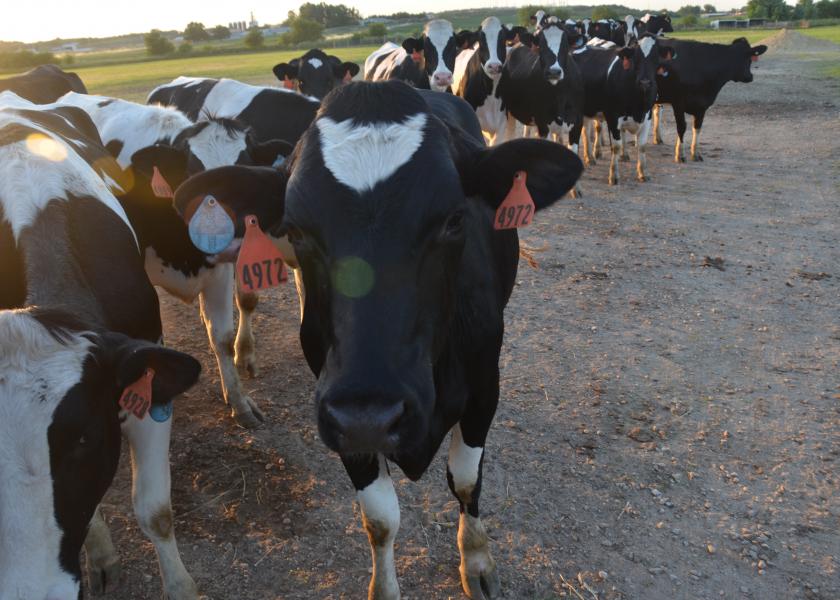Why Heifer Maturity Really, Really Matters

There has been a somewhat on-going but low-key debate over whether calving heifers at early ages increases lifetime milk and revenue. The problem has often been confounded because some dairies find it works well while other dairies find it doesn’t.
Early calving has been promoted because it gets heifers in the milking string faster, decreases heifer inventory numbers and reduces heifer feed and rearing costs. While some of these early calving heifers perform as expected, others don’t.
Gavin Staley, a veterinarian and technical service specialist with Diamond V, has looked at more than 450,000 Dairy Comp records on 174 dairies and believes he has found the answer to the conundrum. Heifer maturity, defined as weight at calving, really, really matters, he says.
In fact, weight at calving not only determines first-lactation performance, it pretty much sets in stone lifetime performance and your herd’s overall performance. “First lactation milk production sets the ‘ceiling’ for the whole herd,” says Staley. “The herd cannot out-perform the production level set by first lactation animals.”
Through the analysis of these records, Staley found four consistent facts in herd after herd:
• At five weeks after calving, 2nd lactation cows will produce 30 pounds more milk than first lactation heifers.
• At five weeks after calving, 3rd lactation cows will produce 8 to 10 pounds more milk than second lactation cows
• These differences appear to be independent of the level of production or milking frequency.
• Herds producing 100 pounds of milk per day (tank average) will have heifers producing 100 pounds per day at 10 weeks after calving.
What drives this is heifer maturity. “Fresh heifers need to be at 85% of mature body weight post calving (close-up heifers should be 95% of mature body weight),” Staley says. If they’re not, heifers will continue to grow during their first lactation, but that growth comes at the expense of milk production.
And here’s the kicker: Every pound of “missing” body weight will cost 7 pounds of milk production. So one month of growth deficit before calving costs 7 months of lactation.
If you calve early, heifers have to grow faster to reach mature body weight. For example, assume your herd’s mature body weight (average weight of 3rd, 4th and 5th lactation cows at 80 to 120 days in milk prior to becoming pregnant) is 1,520 lb. Close-up springers then need to weigh 1,444 lb (95% of mature weight). Subtracting the heifer’s 85 lb weight at birth means the heifer will have to grow 1,359 lb from birth to calving to reach her target growth. Following is the rate of gain she must then achieve, depending on age at freshening:
Age at Freshening Average Daily Growth
21 months (640 days) 2.05
22 months (670 days) 1.98
23 months (700 days) 1.90
24 months (730 days) 1.87
25 months (760 days)_ 1.77
“These are quite ambitious growth rates. Out in the industry, average daily gain is more in the range of 1.75 to 1.8 lb/day,” says Staley.
If you are only achieving 1.8 ADG, heifers calving in at 22 months will not only be slower growing but have fewer days to achieve their mature weight goals, meaning they could be 75 or 100 lb underweight—or more. That has profound impact on milk production. “Sixty pounds of heavier weight at calving equates to 3 to 4 pounds more milk production per day,” says Staley.
There is also within herd variation on heifer weights. In one herd Staley measured, a fourth of the heifers were calving in at less than 1,200 lb. But the best heifers were calving in at over 1,400 lb. There was a 17 lb/day milk difference between these groups.
So what’s the solution? The first thing is to collect data.
- Get mature body weights on your 3rd, 4th and 5th lactation cows at 80 – 120 days in milk.
- Weigh heifers as they freshen.
- Set heifer health and growth goals for all stages of heifer development, from colostrum feeding through calving, and then meet them.
- Weigh calves at various stages of growth to determine if your heifer program is achieving rate of gain goals.
- If you are, you can confidently breed heifers to calve at 22 to 23 months.
- If you are not meeting growth goals, delay breeding so that heifers are reaching their maturity weight goals at calving.
You can learn more by listening to Staley’s 55-minute presentation presented at World Dairy Expo:
https://worlddairyexpo.com/pages/2019-Expo-Seminar-Videos.php
SIDEBAR: Jersey Heifers Follow Same Pattern
Jersey heifers follow the same pattern as Holsteins, producing less milk the earlier they calve. Work by Todd Birkle, a veterinarian and ruminant field specialist with Diamond V, shows that there is nearly a 2,500 lb/cow difference over the first three lactations between Jersey heifers that calve before 21 months of age and those that calve after 23 months.
“This is more than the rBST response in Jerseys,” notes Staley. See chart:
Age at freshening Sum of 1st, 2nd, 3rd Lactation Milk Deviation from Average Sum
19-21 months 56,882 lb -1,154 lb
21-22 months 57,228 lb - 808 lb
22-23 months 58,683 lb + 648 lb
23-24 months 59,350 lb +1,314 lb
Difference between early and 23-24 month calving age 2,468 lb







